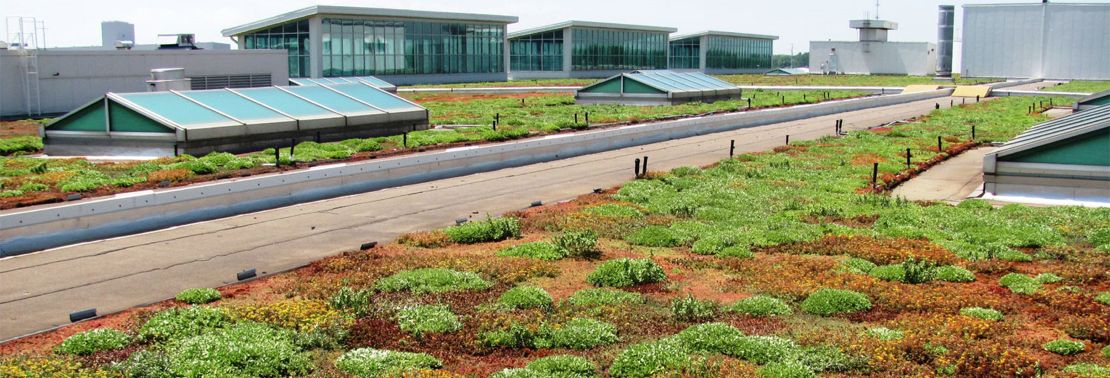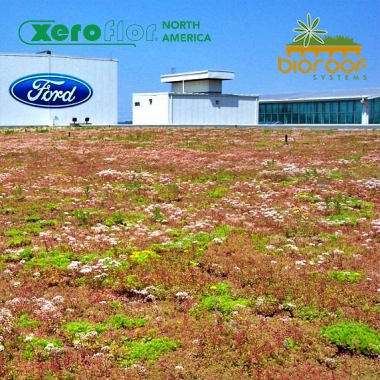Looking Back Ten Years at the Ford Motor Company’s Dearborn River Rouge Green Roof
All Photos Courtesy of Xero Flor America
In the history of the U.S. auto industry – indeed, in the history of American industry – the Ford River Rouge Plant stands out as a legendary manufacturing facility. Constructed between 1917-1928 at the confluence of the Rouge and Detroit Rivers in Dearborn, Michigan, the massive Rouge was the largest industrial complex in the world. It had to be monumental to match the scope of Henry Ford’s bold vision for streamlining mass production by integrating all aspects of automobile manufacturing from raw materials to finished products.
The numbers detailed in the Ford Motor Company’s history of the Rouge are remarkable. The original complex spanned a mile-and-a-half in width and more than a mile in length. It sprawled across 93 buildings with more than 15.7 million square feet of total floor space and 120 miles of conveyors. One hundred miles of railroad tracks and 15 miles of paved roads connected the vast areas of the complex.
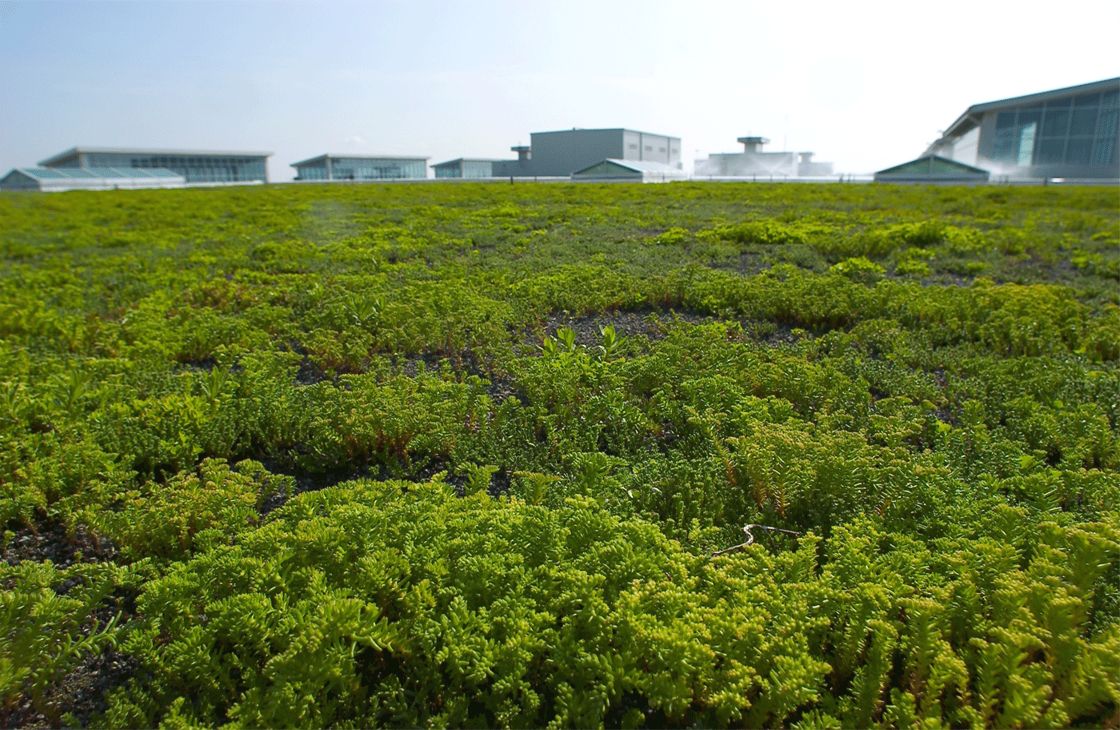
Ford Motor Company’s Dearborn River Rouge Plant Greenroof
The Rouge had a workforce of more than 100,000 by the 1930s. The workers unloaded iron ore at the docks, tended the coke ovens and blast furnaces to forge steel (which they molded it into car parts in the 30-acre foundry), manufactured glass and plastic in specialized factories and turned those materials into car parts, and even made tires. The assembly lines at the Rouge turned out a new Ford Model A every 49 seconds.
At its height, the Rouge symbolized the power and promise of America’s industrial might. But after 80 years, it came to symbolize the ecological perils of highly centralized manufacturing undertaken without an understanding of the impacts on the environment.
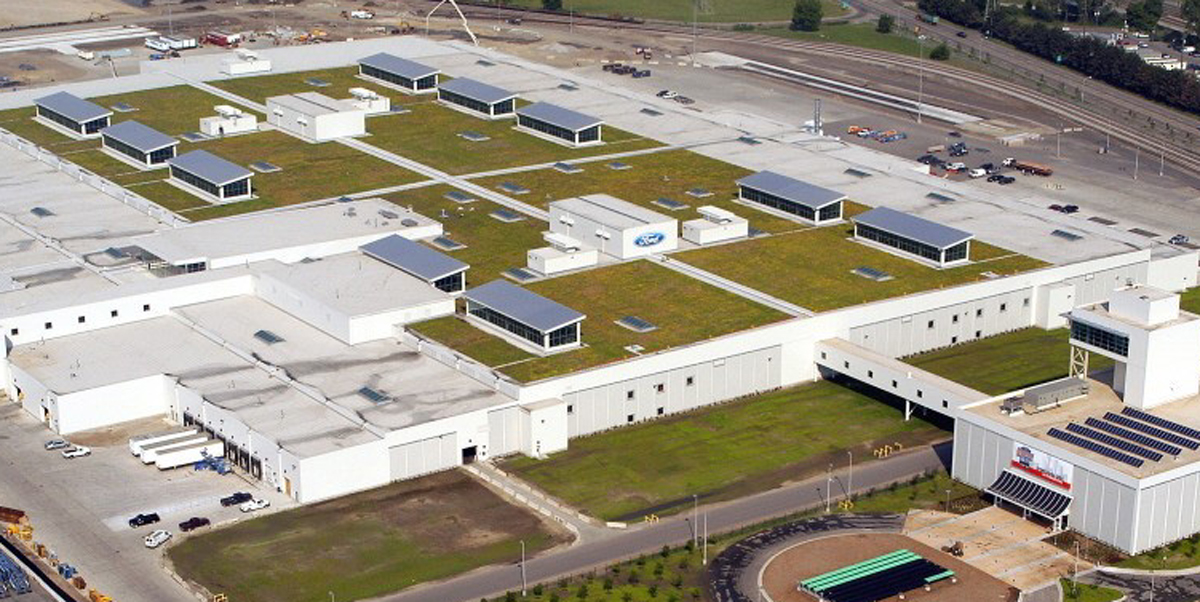
Aerial photo, July 2003
William Clay “Bill” Ford, Jr. (great-grandson of Henry Ford and the executive chairman of Ford Motor Company) and the company’s board made a commitment in the 1990s to transform the Rouge from an outmoded brownfield into a model of industrial-scale sustainability. That decision is a milestone in the history of sustainable development and green building.
The Dearborn Truck Plant green roof is a central element in the renovation project’s pioneering landscaped system for stormwater management. Measuring 454,000 square feet (10.4 acres), it is the biggest green roof on a single, freestanding building in North America and one of the five largest in the world. A landmark in the North American green roof industry, the Rouge green roof marked the tenth anniversary of its completion in April 2013.
Interview with Roger Gaudette
In this interview, Roger Gaudette, director of asset management for Ford Land Corporation and a member of the original project team, comments on the history and status of the green roof.
When the Ford Motor Company decided to renovate the Rouge, what was the status of auto manufacturing at the complex?
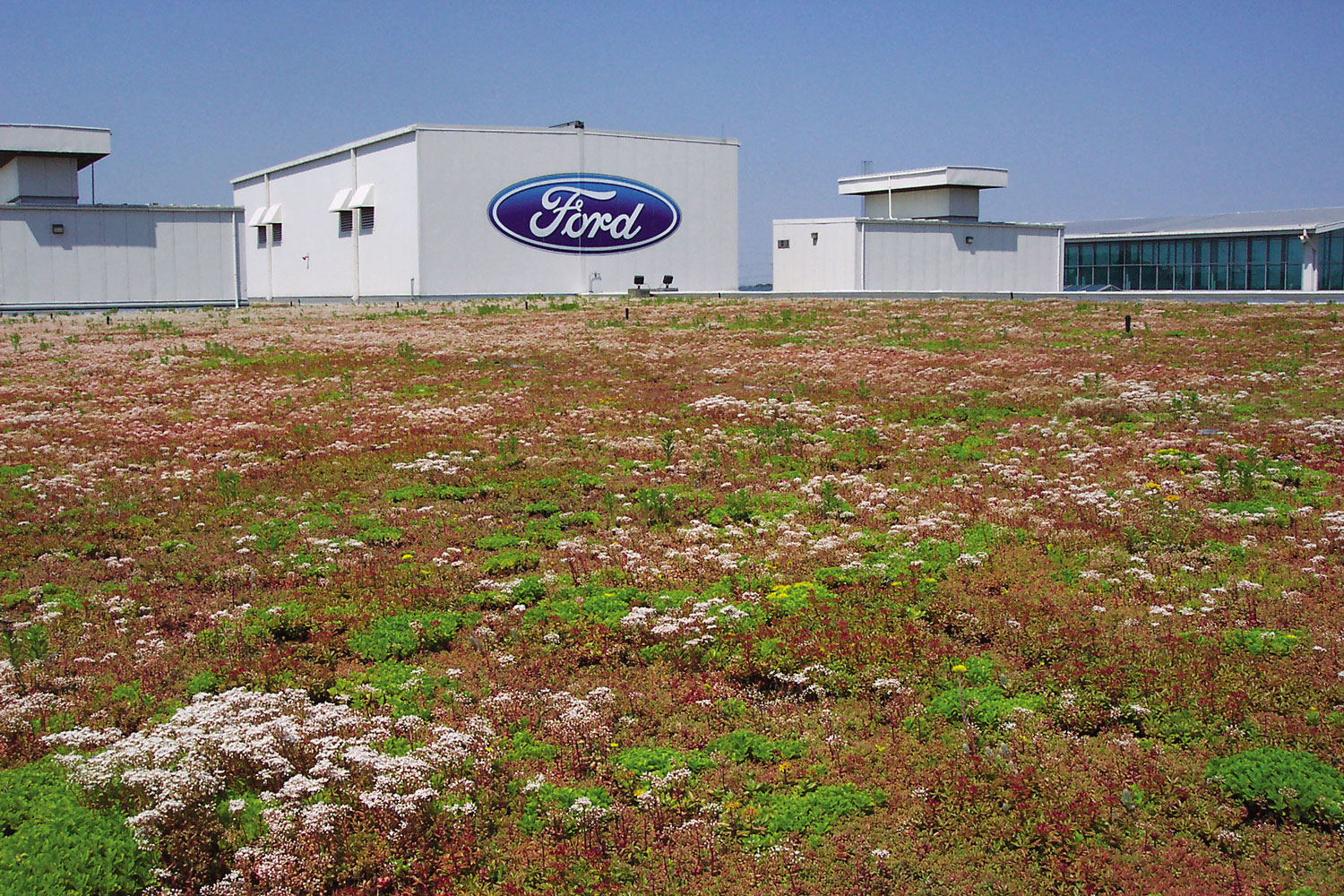
Ford Motor Company’s River Rouge Plant Greenroof in Full Bloom, 2006. The River Rouge Plant is also known as Ford Dearborn Truck Assembly Plant.
At the time, the auto industry, like many manufacturers, was turning away from its historic industrial facilities and factories. It was an era of downsizing and decentralizing. By 1992, the Mustang was the only car still built at the Rouge. Ford and the UAW hammered out an agreement to modernize and maintain vehicle manufacturing at the Rouge in 1997.
It has been said that Bill Ford’s vision, in its own way, was as audacious as his great-grandfather’s. What did he envision?
Upholding the manufacturing heritage of the Rouge. Bringing it forward into the 21st century as a viable industrial complex and model of sustainable manufacturing. And demonstrating that environmental improvements can be smart business with cost-effective solutions that are worthwhile investments. In 1999, Bill Ford announced the appointment of the architect William McDonough to design the sustainability plan to bring that vision into reality.
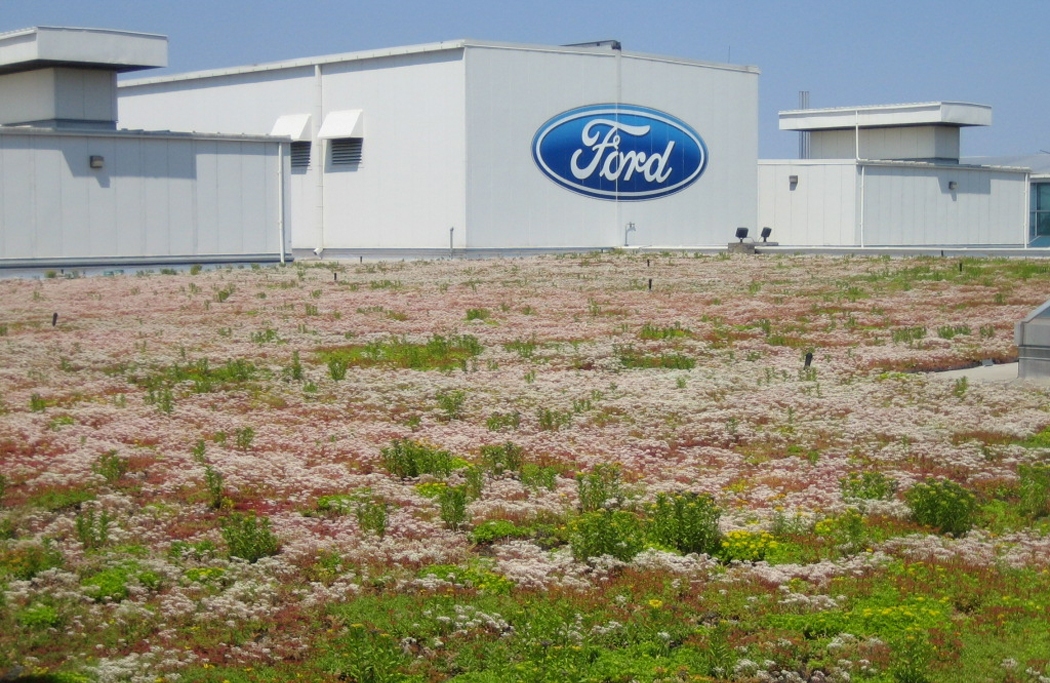
Ford Dearborn River Rouge greenroof in June, 2006
Managing stormwater was essential for the renovation of the Rouge to proceed. Can you summarize the problem?
Henry Ford selected the site because one of its main advantages was access to the rivers for shipping. But, it is low-lying land, and the Rouge was built on multitudes of wooden pilings. Over the years, it was paved over with impervious surfaces. The two main box culverts running through the complex also drain part of the City of Dearborn to the Rouge River. As the city and the complex both grew, more of the area was paved over, as in many urban areas. Runoff increased, and the infrastructure just did not have sufficient capacity.
So flooding was the problem, especially flooding in the buildings during very heavy rains. If Ford was going to maintain manufacturing at the Rouge, we needed to control and treat the stormwater.
William McDonough conceived the design of a comprehensive landscaped system to manage stormwater. Can you describe the system?
The system encompasses 100 acres of sustainable landscaping. It includes the 10.4-acre green roof on the truck plant, a 16-acre porous pavement storage lot for trucks coming off the assembly line, more than a dozen hedgerows and bio-swales, stormwater ponds and treatment wetlands at several locations, and native and sustainable plantings along the roadways.
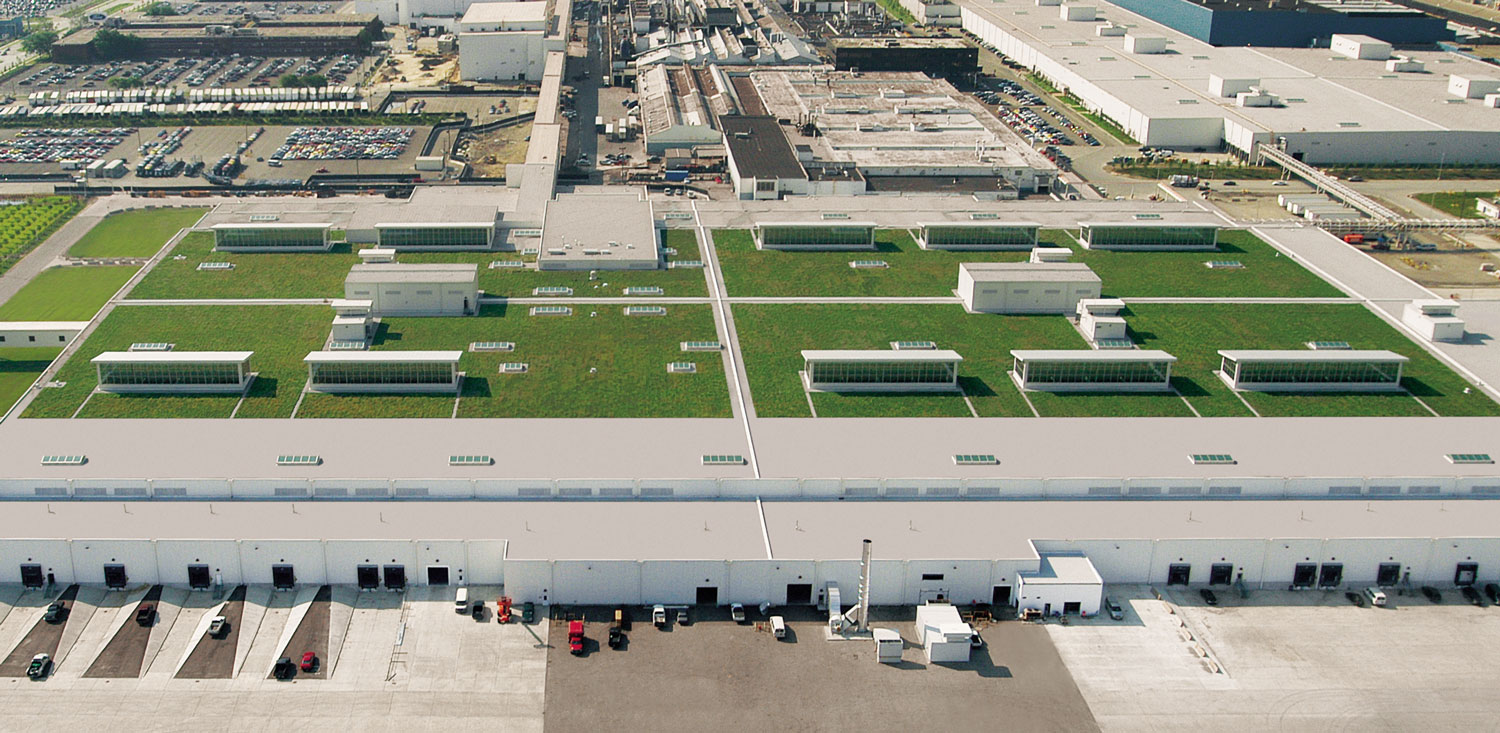
Aerial photo, November 2007
Why was a green roof incorporated into the plan?
Bill McDonough suggested it, and it certainly is a critical part of the overall plan. The other components at ground level, such as the wetlands, would have had to be much larger without it. In addition, Ford wanted a green roof not just for stormwater mitigation but also to green up the site and protect the waterproof membrane on the truck plant’s new roof.
At the time, what was the fundamental challenge in finding a green roof system?
Remember that this was back in 2000. The various measures Bill McDonough suggested to the project team did not have that much of a track record at the time, especially at the scale we would be applying them. That was the case with the green roof. At the time, there was no green roof industry to speak of – or even very many studies on green roof installations ¬– in the United States. That is why we ended up going to Germany.
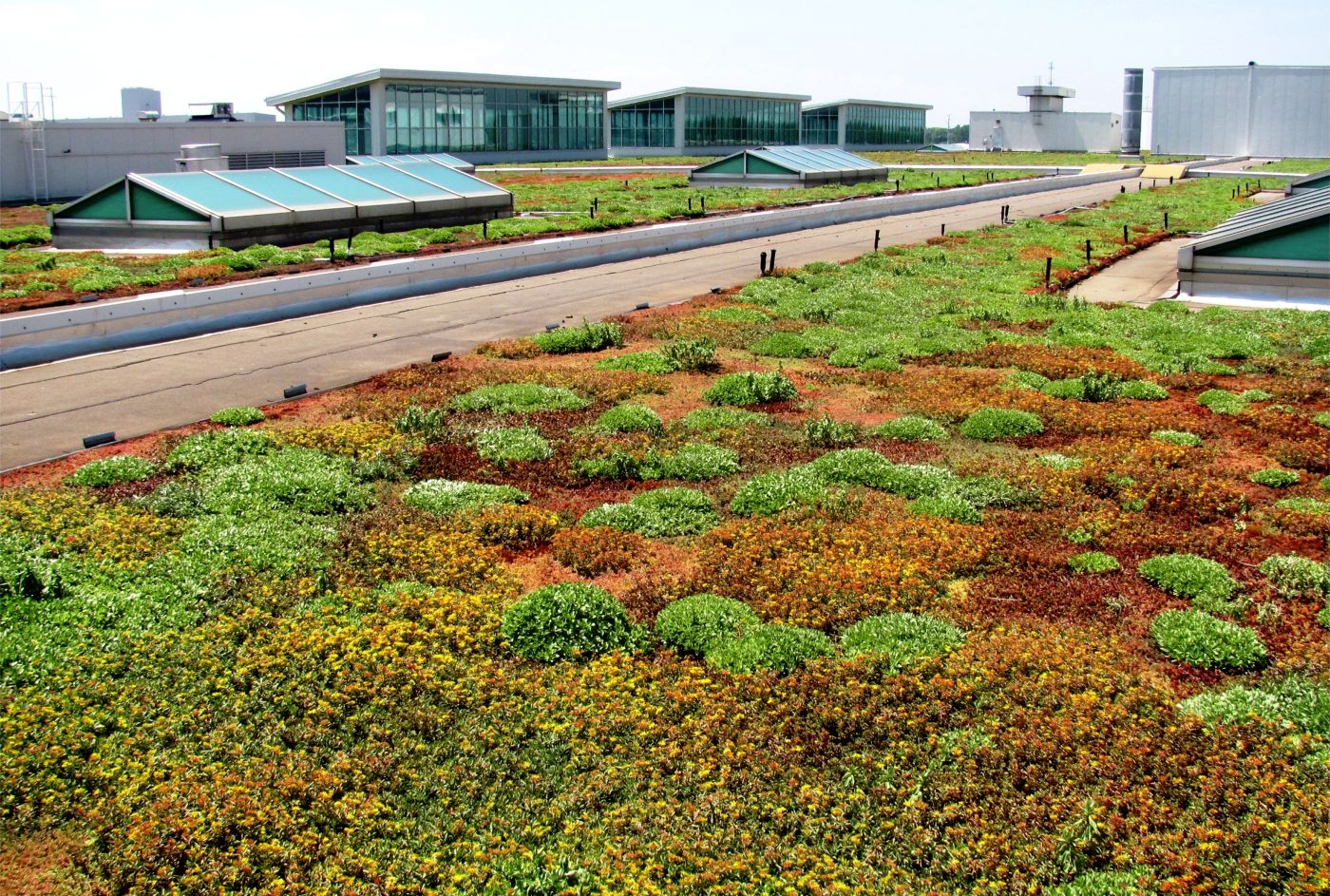
The Ford Dearborn River Rouge Plant greenroof in May, 2012
What did the project team learn in Germany?
Most of the green roofs we visited were build-in-place systems with four to six inches of growing medium planted with plugs that fill in over time. However, because of the vast area to be covered, for the Rouge we needed a lighter weight alternative to reduce the structural loading of the building. We were also concerned with a build-in-place system about the risk of leaving so large a surface area of soil, more than ten acres, exposed to erosion and weed encroachment while the plants grew in over several years.
Did the project team try devising a new system with trays?
Yes, but that was more of a learning experiment.
In the end, what were the most important requirements in choosing a green roof system?
The attributes we were looking for include the essential considerations that go into evaluating alternatives for many green roof projects today: light weight, ease of installation, minimal long-term maintenance, an instant green roof installed with full-grown plants, proven performance.
What system was selected?
The Xero Flor Green Roof System. Originally engineered in Germany, it was the available system at the time we thought would work best. At that point, it had been in use for about 30 years, and that was reassuring.
Why did the project team select this system?
Xero Flor is a pre-vegetated mat system. The mats are thin and light. The specific option we selected is installed with just 1.25 inches of growing medium integrated into the mats, and it weighs less than ten pounds per square foot when fully saturated with rainwater. The mats are pre-cultivated on the ground. They go up on the roof with full-grown, mature plants and 90 percent-plus plant coverage for an instant green roof.
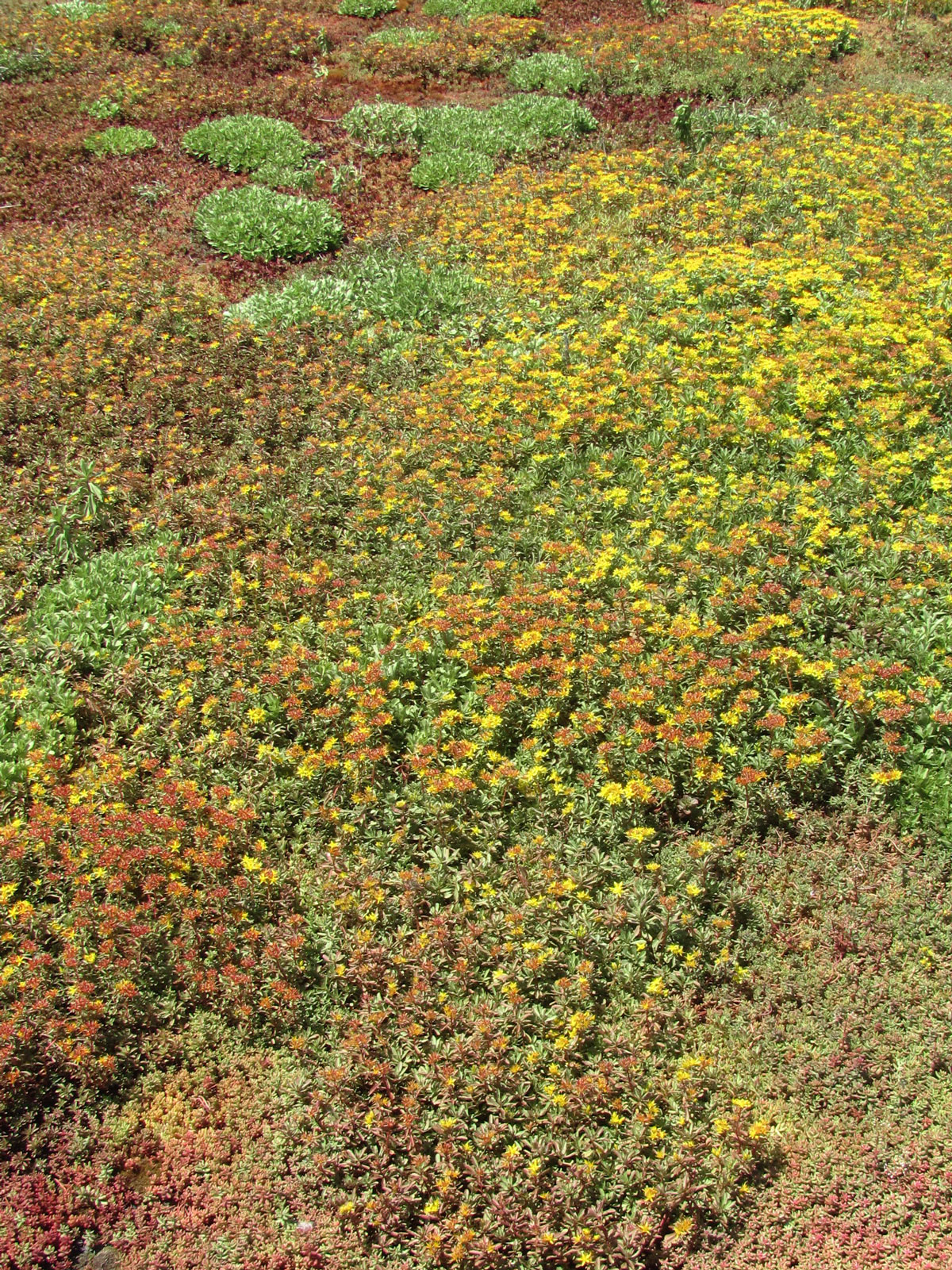
Close-up of the Sedums in May, 2012.
How effectively does the overall landscaped system control stormwater?
It is very effective. It takes 48 hours for a drop of stormwater to flow through the landscaped system. It captures and treats stormwater for a once-in-ten-year, 24-hour storm (about three to four inches of rain) and achieves flood protection for up to a once-in-a-century, 24-hour storm (about five inches rain). It reduces total suspended solids in the stormwater by 85 percent.
How about the stormwater retention of the green roof itself?
The region’s average yearly rainfall totals 31 inches, and the green roof itself retains more than 4.3 million gallons of runoff annually.
What are the other primary benefits of the green roof?
By shading and insulating the truck plant’s roof, the green roof decreases the building’s energy use by five percent. We have inspected and tested the waterproof membrane under the green roof and on unprotected sections of the roof. The membrane under the green roof evidences very little change compared to the expected degradation of the exposed membrane. Overall, the Xero Flor system has performed so well that Ford installed it in 2012 for the new 3,465-square-foot green roof on a portion of our world headquarters building.
What are the Dearborn Truck Plant green roof’s maintenance requirements?
We have had the same maintenance routine in place for a decade. The roof is fertilized each spring. It does not require routine inspection for weeds. That is one of the main advantages of thin pre-vegetative mats installed without several additional inches of growing medium. This design minimizes weed encroachment because it is difficult for weeds to take hold in a very thin layer of growing medium.
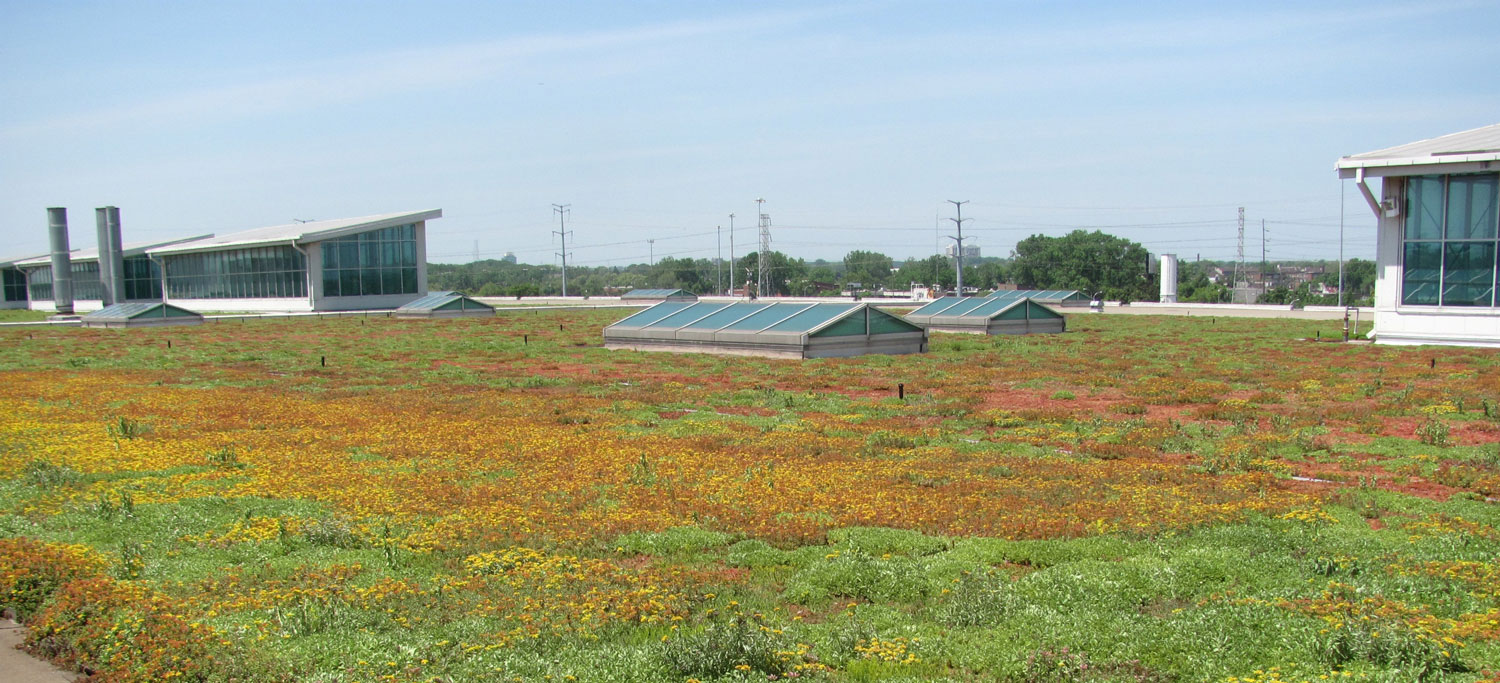
The Ford Dearborn River Rouge Plant living roof in May, 2012
Does the green roof require supplemental irrigation?
As a sort of insurance policy, we put in a commercial irrigation system when we installed the green roof. It uses the industrial mill water system that exists through the site for manufacturing process cooling. We used it regularly during the first growing season. In subsequent summers, the roof has been irrigated only about once a month during especially hot, dry spells.
What is the condition of the green roof today? [As of October 22, 2013]
Outstanding. The original Xero Flor mats retain a very healthy appearance with a dynamic mix of plant varieties. The most recent plant coverage study, conducted in 2010, found that 13 of the 15 original species were thriving with 93 percent to 98 percent coverage of hearty vegetation thriving across the roof.
After a decade, is there anything about the green roof that surprises you?
Yes, I am still surprised by the variety of wildlife that has found a home up there . Killdeers and other birds nest on the roof. Butterflies, dragonflies and bees are there in abundance. We have a habitat for wildlife right in the middle of an industrial complex.
What lessons learned do you consider most important?
The Dearborn Truck Plant green roof proved that a thin mat system, weighing only eight to nine pounds per square foot fully saturated, is practical and effective for a large-scale installation. We learned that a mat system with a thin layer of growing medium can be maintained without a great deal of routine attention. We demonstrated that a landscaped alternative for stormwater management including a pre-vegetated mat green roof can be successful and cost-effective.
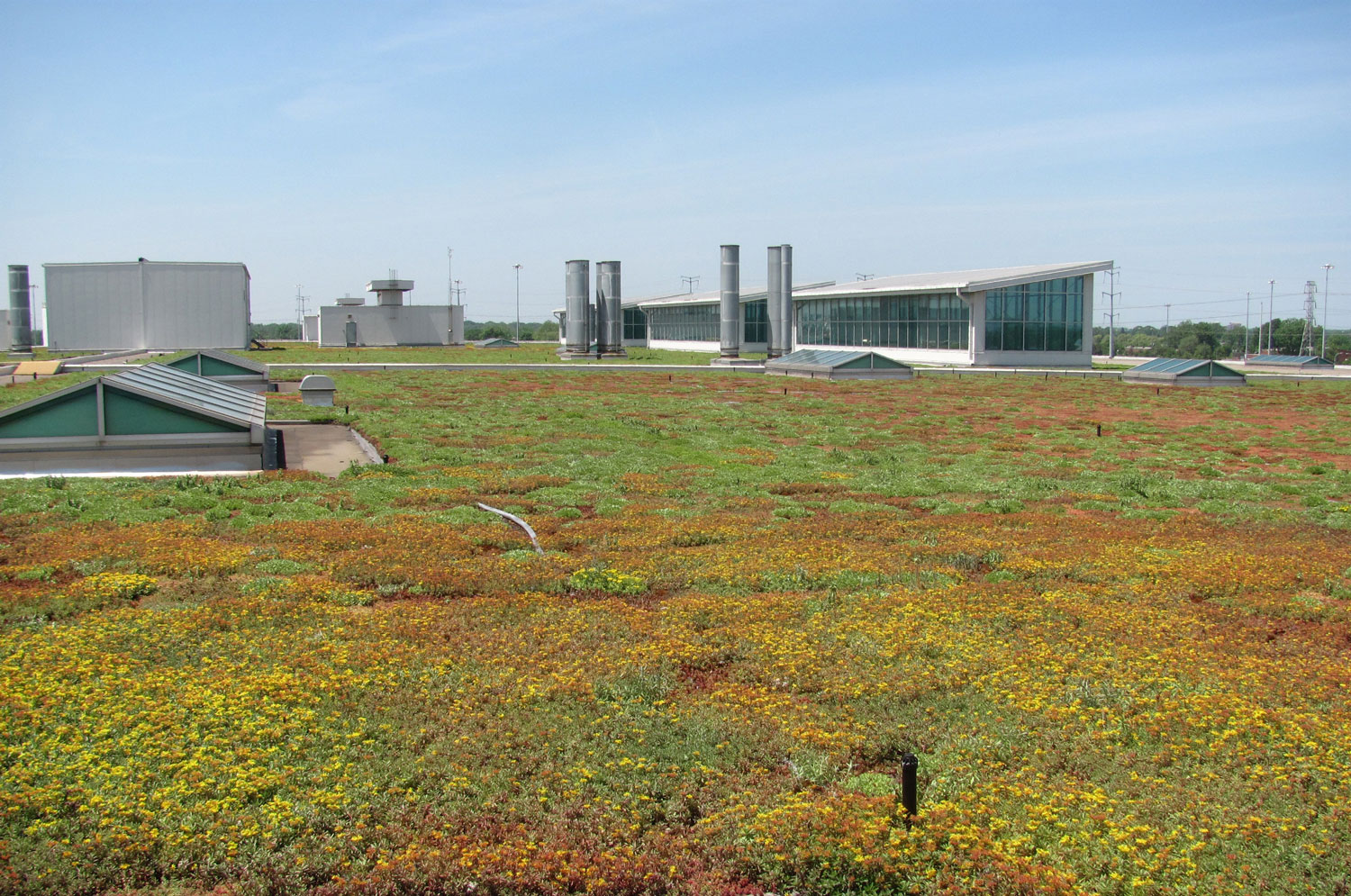
Ford Motor Company’s River Rouge Plant, May, 2012
The Ford Rouge Tour includes a walk out onto an 80-foot-high observation deck that overlooks the green roof. Do you still go out there?
Every few months I walk out on the deck. Most of my colleagues on the project team a decade ago have moved on. Some have left Ford or retired. Some like me have taken on new assignments.
When I look out on the green roof, it still gives me a tremendous feeling of pride in what we accomplished together.
~ David Aquilina
Publisher’s Note: See the Ford Motor Company’s River Rouge Plant Project Profile in the Greenroofs.com Projects Database. Learn about Xero Flor America in the Greenroofs.com Directory.
David Aquilina

David Aquilina, Strategic Storyteller (www.linkedin.com/in/davidaquilina), is a corporate communications consultant and freelance writer. Xero Flor America is one of his clients. David makes his home up on the edge of the northern prairie in Minneapolis, Minnesota.
Contact David Aquilina:
davida@strategicstoryteller.com
StrategicStoryteller.com
 Greenroofs.comConnecting the Planet + Living Architecture
Greenroofs.comConnecting the Planet + Living Architecture
